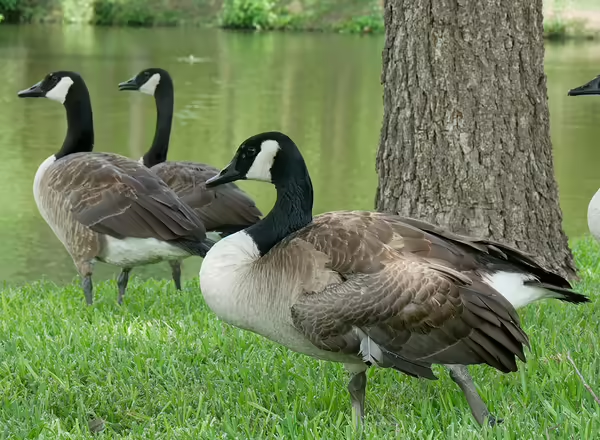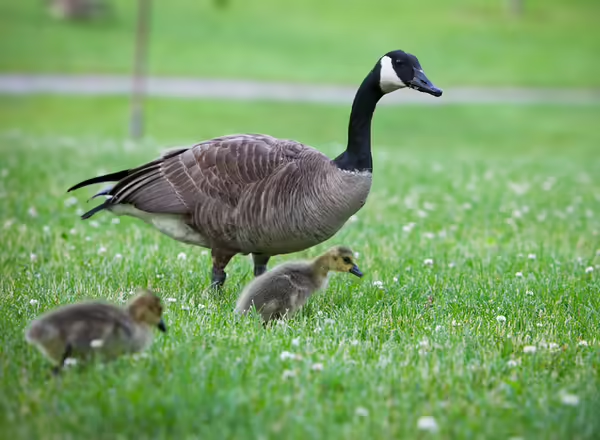
Canada Goose
Habitat for the Canada Goose, branta candensis, includes any turfgrass and natural areas adjacent to ponds, lakes, and other water bodies. Although geese feed on grass, feeding damage is rare except in newly-seeded areas. They are primarily a nuisance from the feces that they produce, which is greenish, 2-3 inches long, and 1/4 to 1/2 inch in diameter. Canada geese tend to be present in flocks of a dozen or more which deposit large amounts of manure on walkways and turf areas. Particularly during their nesting season, they can also be aggressively protective of their eggs and young goslings

The Canada goose is a large bird up to 2 ft long with a wingspread of more than 4 feet. It has a black head and neck with a white cheek. The rest of the bird is mottled brown and white with the underside containing more white and the back being browner. They nest on the ground near bodies of water, with the resulting goslings following their parents on land and into the water soon after hatching. They feed on grains, grass, and aquatic vegetation.

Geese migrate by day and night, with numbers increasing during the winter in Illinois due to migration from the north. Although this bird tended to be primarily migratory, in recent years resident flocks have developed near ponds, lakes, and other water bodies in business and residential areas as well as golf courses. In these locations, food is plentiful and they are not subject to hunting pressures or natural predators. As a result, they do not migrate, but are present year-round. They are capable of flying hundreds of miles per day. When water bodies freeze, they will migrate to warmer areas for a few days, returning when the weather warms.
Management
These are protected birds, but permits for management can be obtained from the Illinois Department of Natural Resources. With permits, their eggs can be replaced with artificial eggs or they can be spun to kill the embryo and returned to the nest. If the eggs are just removed, the geese will quickly lay another batch. However, they will continue to brood artificial or dead eggs until it is too late to nest again. These activities at least keep the flock from growing in size. Canada geese are subject to a hunting season, but most flocks associated with fine turfgrass areas are located in urban areas where hunting is restricted.
Trained dogs, usually border collies and other herding dogs, can be used to chase and harass the geese several times per week. Contracting with a pest control firm that provides this service avoids having to obtain the proper dogs, maintain, and train them. The contracted firm will also possess the necessary permits for this activity from the Illinois Department of Natural Resources. There is a repellent with a grape pulp base that is available. However, in some situations its appearance and odor are objectionable to people in the area. It is sporadic in its effectiveness.
An important Canada goose behavior is to run into a body of water when danger threatens. They prefer to run rather than fly. Erecting a fence that is at least a foot high within a few feet of the edge of a preferred body of water will usually cause the geese to go elsewhere. Even a fence this short is not practical in many situations, but has been used effectively to reduce or eliminate geese in housing and business developments.
Plants Affected
Turf
- Annual ryegrass (Italian ryegrass) (Lolium multiflorum)
- Bermudagrass (Cynodon spp.)
- Creeping bentgrass (Agrostis palustris [A. stolonifera])
- Fine fescues (Festuca spp.)
- Kentucky bluegrass (Poa pratensis)
- Perennial ryegrass (Lolium perenne)
- Roughstalk bluegrass (Poa trivialis)
- Tall fescue (Festuca arundinacea)
- Zoysiagrass (Zoysia spp.)